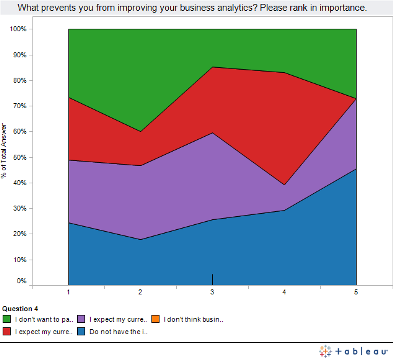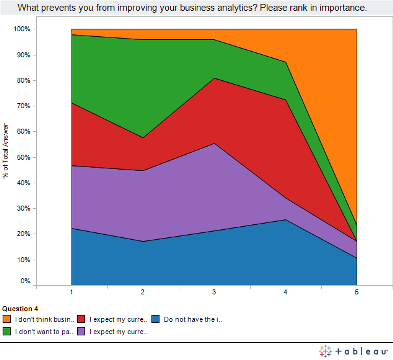Barriers to Improving Business Analytics in Radiology
What prevents radiology groups from improving business analytics? The final part of our survey analysis explores the barriers.
This is the third part in a series analyzing the results of a survey conducted on Diagnostic Imaging regarding use of business analytics in radiology. Click here for Part 1 on current reporting practices and here for Part 2 on doing more with less.
Click on each chart to explore the interactive data.
What prevents you from improving your business analytics? Please rank in importance.
1. I don’t want to pay high software and implementation costs -2.396
2. I expect my current vendors to provide better reporting; and I want it for free - 2.458
3. I do not have the internal resources to implement and manage business analytics -2.750
4. I expect my current vendors to provide better reporting, but I am willing to pay extra - 2.771
5. I don’t think business analytics can help me in my business - 4.583
The first place to start on this question is the worst performing answer (orange): I don’t think business analytics can help me in my business. It earned an average ranking of 4.583. It was ranked number five 77percent of the time. The response is clear that a vast majority of respondents feel that business analytics can help them in their business.
The rest of the answers divide up the reasons behind not making an investment in analytics. At the core are two things that prevent improving business analytics: return on investment and distribution channel. To compare the remaining answers in the chart below, I removed the last place answer to see how the others compare.

Let’s address first the question of distribution channel. There is a sense in radiology and perhaps health care in general that lack of business analytics is a failure of the existing vendors.
Can existing software and service vendors provide better reporting? Yes, they can, and should. Does this mean that they should provide business analytics? The answer is it depends - but I have my doubts. Business analytics can answer questions like why are things happening, if the trends continue what will happen next (that is, predict), and what is the best that can happen (that is, optimize). This goes beyond just improving reports out of existing systems.
The second highest rating and almost tied for first place is (purple): I expect my current vendors to provide better reporting; and I want it for free. In fourth place (red): I expect my current vendors to provide better reporting, but I am willing to pay extra. It should come as no surprise that free ranks higher than paying extra.
Buying through an existing vendor has a lot of benefits. Sales costs are lower, which can reduce the costs significantly. There is already a relationship, which can increase odds of success. Data structure and content is already known and understood, which will lead to the lower implementation costs. Not to mention you won’t have another vendor relationship to manage.
Buying business analytics through an existing vendor doesn’t come without its own risks, because it isn’t their main business line. It could be like getting a haircut from a pet groomer. They may have all the equipment and they know how to cut hair, but don’t be surprised when you come out looking like a poodle.
This brings us to the next issue, which is return on investment. This ROI risk is why the No. 1 reason for not improving analytics is (green): not wanting to pay high software and implementation costs. Implicit in the reasons preventing respondents from improving business analytics is the risk that the costs exceed the benefit. Fantastic if the insights improve profits $200,000 a year. Not worth it if the costs to gain that insight are $225,000 a year. Value equals quality plus cost. We recognize that business analytics can help - but quality can only be measured after the costs are paid, so value isn’t clear in the beginning.
Another ROI risk is in third place (blue): I do not have the internal resources to implement and manage business analytics. The interesting result from this answer is how flatly it was ranked. It is an underlying concern for everyone. The respondents understand consistently the technical and business specialty needed to provide true insight to make sure that there is a good return on the expenditure.
The results of this survey indicate that there is a great opportunity to take advantage of business analytics in radiology. There is a need for better reporting from clinical and financial systems. Many people believe that they can use their data to improve their operations. Even though there are risks and concerns, the future looks very bright.
David Fuhriman, MBA, CPA, is CEO of Bern Medical.
The Reading Room Podcast: Current Perspectives on the Updated Appropriate Use Criteria for Brain PET
March 18th 2025In a new podcast, Satoshi Minoshima, M.D., Ph.D., and James Williams, Ph.D., share their insights on the recently updated appropriate use criteria for amyloid PET and tau PET in patients with mild cognitive impairment.
Meta-Analysis Shows Merits of AI with CTA Detection of Coronary Artery Stenosis and Calcified Plaque
April 16th 2025Artificial intelligence demonstrated higher AUC, sensitivity, and specificity than radiologists for detecting coronary artery stenosis > 50 percent on computed tomography angiography (CTA), according to a new 17-study meta-analysis.

